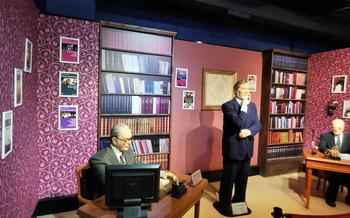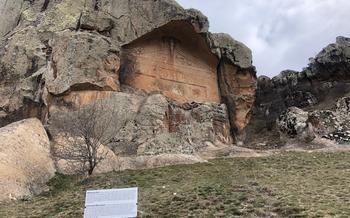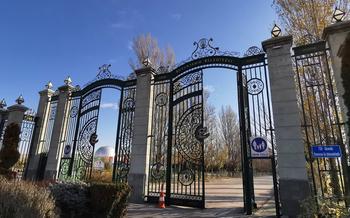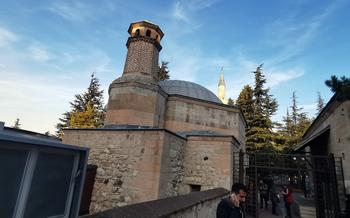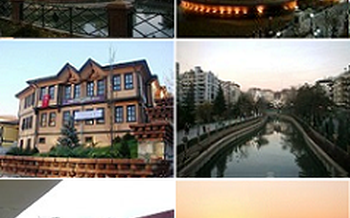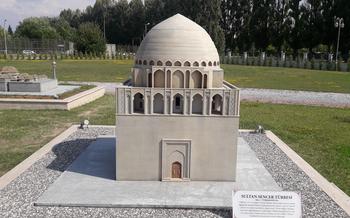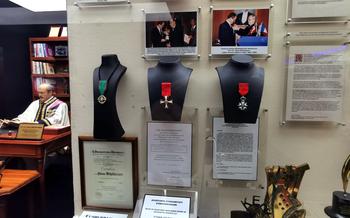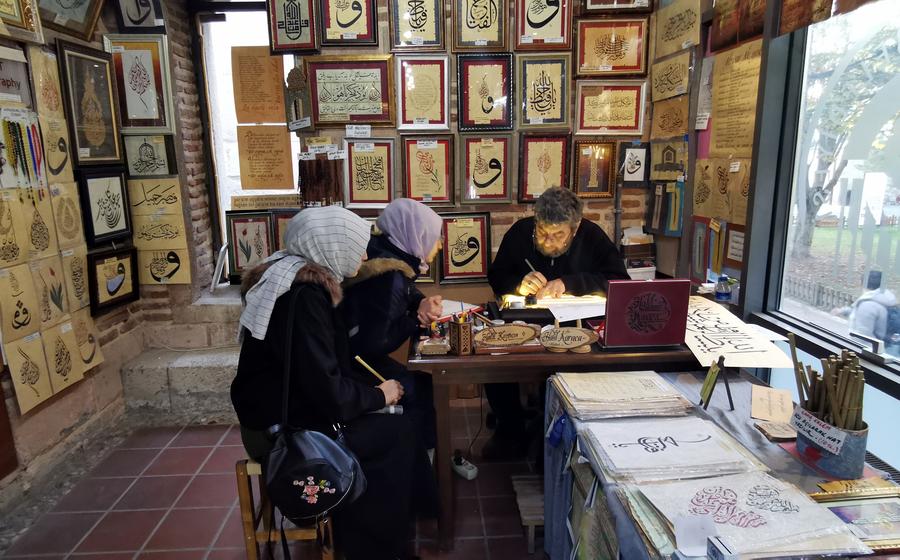
Nasrettin Hoca Archaeology and Ethnography Museum
- Exploring the Museum's Collections: A Journey Through History and Culture
- Travel Through Time with Historical Artifacts
- Discover Local Traditions and Customs
- Immerse in the Life of Nasrettin Hoca
- Unravel the Secrets of Ancient Civilizations
- Engage with Interactive Exhibits
- Admire the Architectural Beauty
- Browse the Museum Shop for Souvenirs
- Special Exhibitions and Events
- Accessibility for All
- Getting There
- Capture Your Memories
- Insider Tip: Embracing the Off-season Charm
Exploring the Museum's Collections: A Journey Through History and Culture
The Nasrettin Hoca Archaeology and Ethnography Museum houses a diverse and captivating collection of artifacts and exhibits that take visitors on a journey through the rich history and culture of the region. Archaeological findings from various periods, including prehistoric times, the Phrygian, Roman, and Byzantine eras, provide insights into the rise and fall of ancient civilizations. Tools, weapons, religious objects, and sculptures showcase the daily lives and spiritual beliefs of past societies.
Equally fascinating are the ethnographic displays that highlight local culture and traditions. Traditional clothing and textiles, intricate handicrafts, musical instruments, and household objects offer a glimpse into the vibrant heritage of Eskişehir and the surrounding region. Visitors can marvel at the exquisite craftsmanship and artistic expression that characterize these items, each of which tells a story of the region's unique identity.
Travel Through Time with Historical Artifacts
Journey through the annals of time as you explore the museum's rich collection of historical artifacts, each narrating a unique tale of past civilizations. Gaze upon ancient coins that once clinked in the pockets of long-forgotten merchants, revealing the economic prowess of bygone eras. Marvel at intricately designed pottery, adorned with symbols and motifs that speak to the artistic sensibilities of ancient civilizations. Discover tools and weapons that provide glimpses into the daily lives of our ancestors, their struggles for survival, and their ingenuity in crafting instruments for various tasks. Encounter religious objects and sculptures that showcase the spiritual beliefs and practices of different cultures, offering insights into the sacred and the divine. Delve into manuscripts and documents that have preserved historical records, knowledge, and stories, ensuring that the past continues to resonate in the present.
Discover Local Traditions and Customs
The Nasrettin Hoca Archaeology and Ethnography Museum offers a fascinating glimpse into the rich cultural heritage of Eskişehir and the surrounding region. Ethnographic displays showcase traditional clothing and textiles, reflecting the unique styles and craftsmanship of the local people. Visitors can admire intricate embroidery, colorful fabrics, and traditional costumes that tell stories of past generations.
Handicrafts and decorative arts provide another window into the region's artistic traditions. Exquisite pottery, intricate woodwork, and delicate metalwork showcase the skill and creativity of local artisans. From ornate jewelry to hand-woven carpets, these objects offer a tangible connection to the region's cultural heritage.
Musical instruments and folk art further enrich the museum's ethnographic collection. Traditional instruments like the bağlama and the darbuka fill the air with melodious tunes, while colorful folk paintings and sculptures depict scenes from daily life and local legends. These artifacts provide a vibrant and engaging representation of the region's cultural identity.
Household objects and tools offer a glimpse into the daily lives of the people who have inhabited this region for centuries. Cooking utensils, furniture, and agricultural implements tell stories of past livelihoods and domestic practices. These objects not only provide a practical insight into the region's history but also evoke a sense of connection to the people who have shaped its culture.
Immerse in the Life of Nasrettin Hoca
Journey into the captivating world of Nasrettin Hoca, a beloved figure celebrated for his humorous anecdotes and life lessons. Through interactive displays and engaging storytelling, the museum brings Nasreddin Hoca to life, revealing the wisdom and wit behind his legendary tales. Discover the humorous anecdotes that have made Nasrettin Hoca a cultural icon, and gain insights into his teachings that continue to resonate with people worldwide. Explore the connection between the museum and Nasrettin Hoca's legacy, and leave with a deeper understanding of this extraordinary figure and his enduring impact on Turkish culture and beyond.
Unravel the Secrets of Ancient Civilizations
Step back in time as you explore the rich archaeological discoveries housed within the Nasrettin Hoca Archaeology and Ethnography Museum. Unearth the secrets of ancient civilizations that once flourished in this region. Discover artifacts from prehistoric times, shedding light on the earliest human settlements and their way of life. Delve into the captivating history of the Phrygian, Roman, and Byzantine civilizations, as their remnants tell tales of grandeur, power, and cultural exchange. Immerse yourself in the rise and fall of empires, gaining insights into the forces that shaped the course of history. Interactive maps and timelines provide a comprehensive context, allowing you to piece together the fascinating puzzle of ancient civilizations.
Engage with Interactive Exhibits
Beyond the wealth of artifacts and displays, the Nasrettin Hoca Archaeology and Ethnography Museum offers a range of interactive exhibits that bring history to life and make learning an immersive experience. Touchscreens and multimedia presentations provide in-depth information on various topics, allowing visitors to explore at their own pace. Virtual reality experiences transport visitors back in time, offering a glimpse into the lives and customs of ancient civilizations. 3D models and replicas of artifacts encourage hands-on exploration, enabling visitors to get up close and personal with the past. Audio guides and guided tours are available for those seeking a more comprehensive understanding of the museum's collections. These interactive elements make the museum a vibrant and engaging space, catering to visitors of all ages and interests, ensuring a memorable and educational experience.
Admire the Architectural Beauty
The Nasrettin Hoca Archaeology and Ethnography Museum is housed in a stunning Ottoman-style building that is as much a work of art as the artifacts it contains. Built in the early 20th century, the museum's architecture reflects the rich cultural heritage of the region. The exterior facade is adorned with intricate stone carvings and decorative elements, showcasing the exquisite craftsmanship of the era.
As you step inside, you'll be greeted by a central courtyard that provides a serene oasis amidst the hustle and bustle of the city. Surrounded by lush greenery, the courtyard offers a peaceful spot for contemplation and reflection. The museum's interior spaces are equally impressive, with high ceilings, arched doorways, and polished marble floors.
The harmonious blend of traditional and modern architectural elements creates a unique and inviting atmosphere. The museum's designers have skillfully incorporated modern amenities such as glass display cases and touchscreens while preserving the building's historical character. The result is a space that is both aesthetically pleasing and functional, providing visitors with a truly immersive experience.
Browse the Museum Shop for Souvenirs
As you exit the Nasrettin Hoca Archaeology and Ethnography Museum, don't miss the opportunity to visit the well-stocked museum shop. Here, you'll find a treasure trove of unique gifts and souvenirs that are inspired by the museum's vast collection. Whether you're looking for a memento of your visit or a special gift for a friend or family member, the museum shop has something for everyone.
Peruse the shelves and you'll discover a wide range of traditional Turkish handicrafts, including intricate carpets, colorful ceramics, and delicate jewelry. These items are lovingly crafted by local artisans, showcasing the rich cultural heritage of Eskişehir and the surrounding region.
In addition to traditional handicrafts, the museum shop also offers an array of books and publications related to history and culture. Whether you're interested in learning more about Nasrettin Hoca, the archaeological discoveries made in the region, or the ethnography of Anatolia, you'll find a wealth of resources to delve into.
By purchasing souvenirs from the museum shop, you not only support local artisans but also contribute to the preservation of cultural heritage. So take your time browsing the shop, and find the perfect item to commemorate your visit to the Nasrettin Hoca Archaeology and Ethnography Museum.
Special Exhibitions and Events
The Nasrettin Hoca Archaeology and Ethnography Museum often hosts temporary exhibitions that delve into specific themes or showcase the works of renowned artists. These exhibitions provide visitors with an opportunity to explore different aspects of history, culture, and art. Educational programs and workshops are also organized regularly, catering to visitors of all ages. These programs aim to promote learning, creativity, and cultural appreciation. Additionally, the museum hosts cultural events and performances that celebrate local traditions and customs. These events offer visitors a chance to immerse themselves in the vibrant cultural heritage of the region. To stay updated on upcoming exhibitions, events, and programs, visitors are encouraged to check the museum's website or social media pages.
Accessibility for All
The Nasrettin Hoca Archaeology and Ethnography Museum is committed to providing an inclusive and accessible experience for all visitors. Wheelchair-accessible ramps and elevators ensure that visitors with mobility challenges can easily navigate the museum's various levels. Touchscreen exhibits are designed with accessibility in mind, featuring user-friendly interfaces and closed captions for visually impaired visitors. Audio guides are available in multiple languages, allowing visitors from different linguistic backgrounds to fully immerse themselves in the museum's exhibits. The museum staff is trained to assist visitors with disabilities, providing support and guidance throughout their visit.
Getting There
Located in the vibrant city of Eskişehir, the Nasrettin Hoca Archaeology and Ethnography Museum is easily accessible and conveniently situated in the heart of the city. Take a leisurely stroll through the charming streets and reach the museum within minutes from prominent landmarks and attractions. Immerse yourself in the city's rich history and culture as you make your way towards the museum, discovering hidden gems along the way. Whether you prefer to explore on foot or utilize the efficient public transportation system, the museum's central location ensures a seamless journey. For those arriving by car, ample parking options are available nearby, providing ease and convenience for visitors.
Capture Your Memories
At the Nasrettin Hoca Archaeology and Ethnography Museum, you are welcome to capture your experiences through photography. This allows you to preserve your memories and share your journey with others. Feel free to take pictures of the captivating exhibits, the stunning architecture, and the serene museum garden. Share your photos on social media using designated hashtags to connect with other travelers and enthusiasts. Your images will not only serve as a reminder of your visit but also contribute to promoting the museum's rich cultural heritage.
Insider Tip: Embracing the Off-season Charm
To truly savor the essence of the Nasrettin Hoca Archaeology and Ethnography Museum, consider planning your visit during the off-season. This magical time of the year, typically falling outside the peak tourist months, offers a unique opportunity to explore the museum's treasures in a more intimate and serene setting.
With fewer visitors, you can take your time browsing the exhibits, engage in meaningful conversations with museum staff, and fully immerse yourself in the captivating stories that the artifacts tell. The tranquil atmosphere allows for deeper contemplation and reflection, ensuring that your visit becomes a truly enriching and memorable experience.



